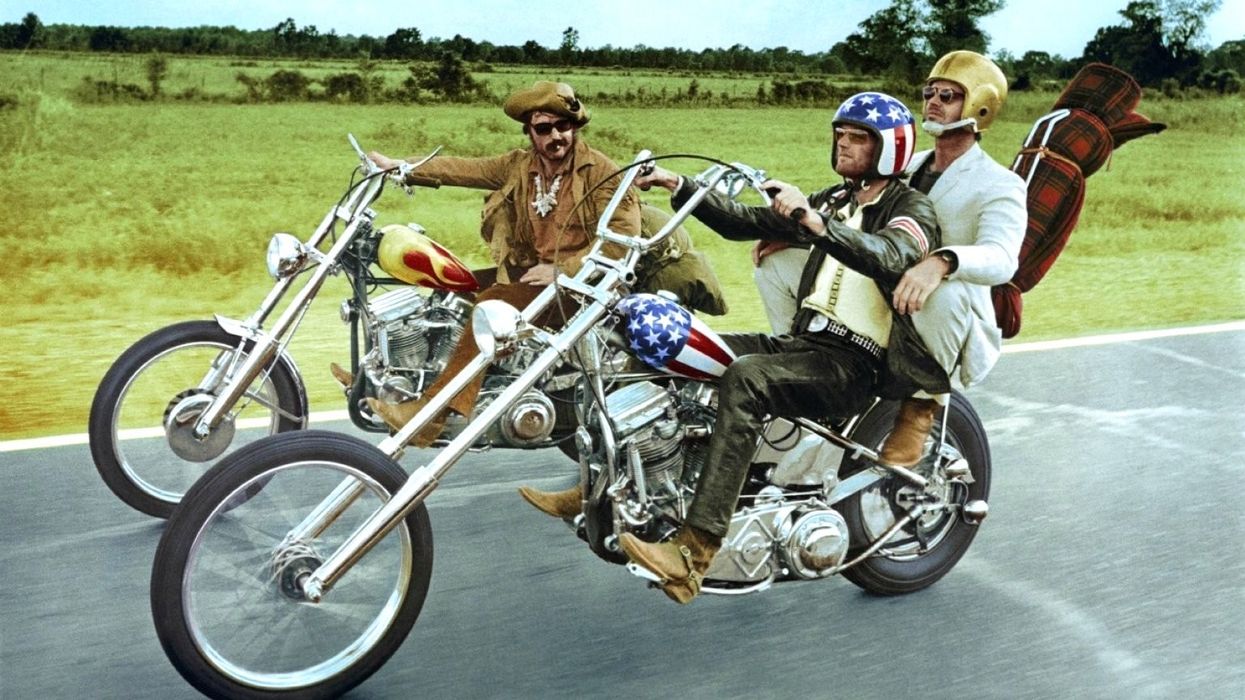How 'Easy Rider' Changed Everything About Indie Film
The 1969 counterculture film "Easy Rider" shook the studio system to its core and helped usher in one of Hollywood's most creative eras.

The film is a revolutionary road movie, starring Peter Fonda as Wyatt and Dennis Hopper as Billy, plus a star-making turn from then-newcomer Jack Nicholson as ACLU lawyer George Hanson.
Wyatt and Billy are drug-dealing hippies traveling from Los Angeles to the American South, including New Orleans, during the height of the tumultuous Vietnam War era. They meet other hippies, do drugs, pick up hitchhikers, and get into mischief before meeting their violent ends.
Criterion has called it "the definitive counterculture blockbuster." The film was a surprise cult hit and led to a seismic shift in many areas of the filmmaking process.
How Easy Rider Pioneered Indie Filmmaking
Fonda and Hopper partnered on the film, co-writing the script, at a time when the movies making money were generally happy, big-budget, shiny projects.
Easy Rider was one of the first successful films to be made outside of the reigning studio system of the period. It was produced for roughly $400,000 by Bert Schneider and Bob Rafelson (the team behind the TV show/pop group The Monkees).
It was a production that flew by the seat of its pants a bit. Though there was a script and source material, co-writer Terry Southern revealed that scenes were heavily improvised.
According to DP László Kovács, the film functioned with a 12-person crew, and the Mardi Gras segments were filmed on rented Bolex 16mm cameras by the actors themselves before production even started.

In 2015, Fonda looked back on his motivation for making the movie during an interview with the Hollywood Reporter.
"They were making films like Pillow Talkand [The] Glass Bottom Boat. Gidget? That's not a kids' film. Beach Blanket Bingo? C'mon. Those were not really films of the youth that I had grown into and up with, shutting away the establishment, going on their own. [...] We made a movie for these people that didn't have their own movie."
Easy Rider's Effect on the Studio System
After the film's completion, it was accepted into the 1969 Cannes Film Festival. Hopper (who also served as the film's director) received the "First Film Award."
Columbia Pictures released Easy Rider on July 14, 1969, starting in a single New York City theater and going wide several months later. It eventually grossed $60 million worldwide and was the third highest-grossing film of the year.
Studio heads were stunned at the movie's success. It looked different, was made for no money, was filmed and edited differently, and dealt with dark subject matter their own glossy movies weren't touching. It gave a voice to a dissatisfied group of Americans who were unhappy with the status of the world.
Executives scrambled to connect with this new "outsider" audience, approving young new directors and stories about rebels and drugs, mostly unsuccessfully. It was impossible to capture the specific formula and spark that made Easy Rider such a smash.
Even more significantly, the film is credited as one of the key works that helped create the New Hollywood movement, which began a new era of creativity and independence in the 1970s.

The Stars Easy Rider Launched
Despite his famous father, Fonda was not a huge audience draw at the time of the film's release, and Hopper was struggling after co-starring with James Dean (Giant, Rebel Without a Cause). In fact, he was kind of doing the Rick Dalton thing and taking guest spots in TV Westerns. And Nicholson was basically unknown.
Easy Rider certainly launched Nicholson's career, earning him an Oscar nod for best-supporting actor and taking him from a relative no-name to a leading man in a matter of years. Just the next year he starred in Five Easy Pieces (directed by Bob Rafelson), then a few short years laterThe Last Detailand Chinatown.
Fonda and Hopper went on to direct, to middling success, but also continued on to extensive acting careers. The film easily cemented all these actors in the American consciousness and made them iconic figures of the counterculture movement.

The Innovative Soundtrack
It would be nearly impossible to divorce the film's soundtrack from its imagery. The movie opens with Steppenwolf's “The Pusher," playing over Fonda stashing drug money inside his motorcycle's fuel tank before the opening credits begin to the driving strains of “Born to Be Wild.”
Tim Greiving's look at the Easy Rider tracklist offers a unique look at the process of creating the film's now-iconic soundtrack.
It wasn't the first time a film opted for pop music over an orchestral score. For example, the 1967 movie The Graduate used Simon and Garfunkel tunes for its score. But Easy Rider took it a step further.
The film started with lots of temp tracks pulled from a record collection. While this process might seem random, the songs were chosen not only for their popularity but also for their impact on the narrative and a reflection of the time period. So, moments of comedy arrive to the tune of “Don’t Bogart Me (AKA Don’t Bogart That Joint)” by the Fraternity of Man, while the darker, edgier "If 6 Was 9" by Jimi Hendrix signals danger.
This "jukebox" style of soundtrack has been widely imitated since then.
What's next? Explore more influential filmmaking
We've got plenty of insight on other impactful movies. Learn about ten film movements that changed the industry. Check out character development in The Graduate. Examine what Seven Samurai teaches about story and structure.
What other films would you consider game-changers in the industry? Let us know in the comments.












